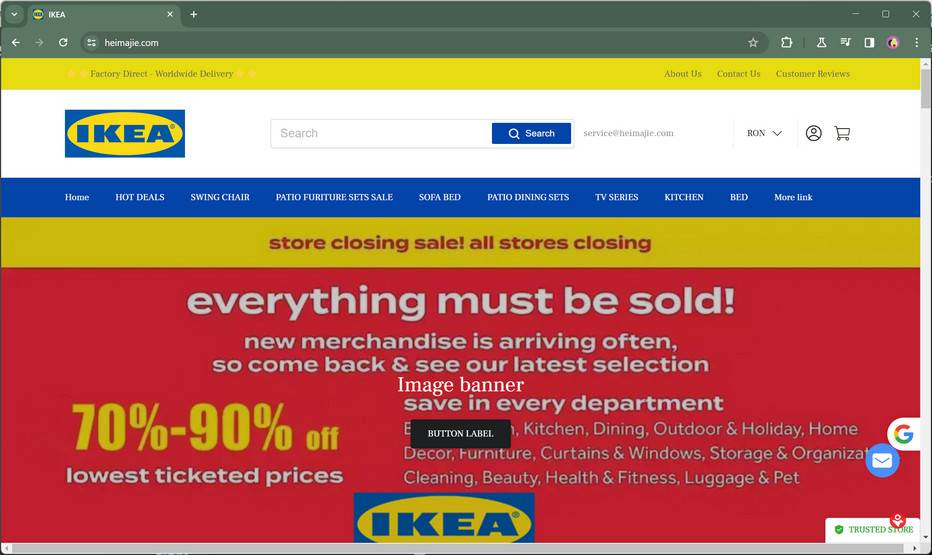IKEA is one of the most well-known furniture and home goods brands worldwide. However, IKEA’s widespread popularity has also caught the attention of scam websites running elaborate fake IKEA clearance sales to steal money and personal information from customers.
This comprehensive article dives into how these fraudulent IKEA clearance scams operate, red flags to spot them, and vitally, what you must do if you fall victim.

Overview of the Fake IKEA Clearance Sale Scam
In recent years, convincing imposter websites promoting massive IKEA clearance events with discounts up to 90% off have emerged to take advantage of the brand’s reputation. They leverage IKEA’s image and mimic official branding and promotions to fool deal-seeking shoppers into handing over payment and personal data.
The scammers behind these fraudulent IKEA clearance scam websites utilize various deceitful tactics:
- The sites use recently registered domain names, often just created weeks or days before launching campaigns. This is a common scam characteristic.
- They provide no legitimate contact information besides dubious email addresses that often go unanswered. No real phone numbers, physical addresses, or customer support contacts are offered.
- The sites brazenly tout absurd discounts up to 90% off high-priced furniture that are too good to be true, even for IKEA. For example, a $500 bookcase for only $50.
- The scam websites utilize template web design with content, images, policies, and other assets likely stolen directly from IKEA’s real website and other sources. This makes them appear more valid at first glance.
- The sites contain enticing slogans and messaging like “Clearance Blowout”, “Limited Time Deals”, and “Free Shipping” to strongly entice deal-seeking shoppers.
- There is zero social media presence, reviews or history for these scam websites aside from the ads used to promote them. No signs point to real businesses.
These fake IKEA Clearance Sale websites are complete shams with the sole purpose of stealing your money and information. Customers who place orders through these fraudulent IKEA sales typically experience one of the following unfortunate outcomes:
- Nothing at all – The most likely result is your order and payment simply disappears with no products shipped.
- Inferior knockoffs – Some orders arrive with poor quality replica furniture made with inferior materials that clearly aren’t real IKEA products.
- Used or defective goods – You may receive items that are visibly flawed, damaged or worn out, indicating no new products are being shipped.
- Completely wrong items – Orders sometimes contain products that are totally different than what was pictured on the scam website.
- Stolen personal and financial data – All customer payment details and personal information entered on the sites goes directly into the hands of scammers.
These elaborate fake IKEA websites are run by interconnected international scam networks that also create fraudulent websites for many other retailers. They operate entire portfolios of retail scam sites to steal from victims worldwide.
How the Fake IKEA Clearance Sale Scam Works
The sophisticated criminals running these fake IKEA clearance scams have developed an efficient process to rip off customers:
Step 1: Create a Fake IKEA Website
The scammers first obtain and set up lookalike domain names containing the IKEA name plus terms like “clearance”, “sale”, “shop”, etc. They make the sites appear legitimate by copying IKEA’s logo, product images, and overall visual design.
Many scam sites also steal IKEA’s “About Us” page, Terms of Service, Privacy Policy, and other legal information verbatim to seem valid at first glance. However, close inspection reveals grammar errors, typos, and duplicated text.
Step 2: Promote Using Influencer Marketing and Social Media Ads
Once the fake sites are ready, the scammers launch influencer marketing campaigns and social media ads directing users to their scam portal. They utilize influencer accounts on Instagram to promote the fraudulent clearance sales featuring stolen product images.
In addition, they invest heavily in Facebook and Instagram ads touting absurd discounts like “85% off everything” to attract bargain hunters. Oftentimes the influencers block commenters who call them out.
Step 3: Lure In Victims with Unbelievably Low Prices
The scam websites prominently tout outlandish discounts up to 90% off retail prices on all IKEA furniture and home goods that are far too good to be true. For example, a $300 bookcase discounted to just $30 or a $600 sofa lowered to only $60.
These unrealistic prices are intended to get shoppers to drop their guard and jump on what they assume is an amazing clearance deal. In reality, the scammers never intend to ship out any real products.
Step 4: Collect Credit Card Details and Personal Info During Checkout
During checkout on the scam websites, customers are prompted to enter their name, home address, phone number, email address and other personal details the fraudsters can use for identity theft.
The sites also collect your credit card number, expiry, CVV code and other payment information. All this data goes straight into the hands of scammers rather than legitimate orders.
Step 5: Cut Off All Communication After Orders Are Placed
Once payments go through, shocked customers find they have no way to contact the sham company besides an email address that is either fake or simply ignored.
The influencer accounts promoting the clearance sales also immediately block anyone calling them out for being complicit. The fraudulent websites soon vanish or get taken down quickly once identified as scams.
Step 6: Repeat the Scam Using New Domain Names and Websites
The scammers then repeat the process with new domain names and website designs. They continue promoting too-good-to-be-true IKEA clearance sales, targeting users who missed previous versions of the scam and believe the deals are real.
This cycle continues, duping wave after wave of eager deal seekers who get tricked by the seemingly amazing discounts and authentic looking websites. The longer the scams operate undetected, the more victims are defrauded and exposed.
8 Red Flags to Identify Fraudulent IKEA Clearance Websites
While the scam IKEA sites may seem legitimate at first glance, several key characteristics expose their fraudulent nature:
- Unrealistically high discounts over 80% off – Genuine IKEA sales rarely exceed 25-30% off. Sites offering more like 90% are too good to be true.
- Recently registered domain names – Scam sites use new domains often registered just weeks before launching campaigns. A WhoIs lookup reveals their fresh creation dates.
- No customer service contact information – No working phone number, address, live chat or support email are provided on scam sites.
- No social media presence – Fraudulent sites won’t have actively used business Facebook, Instagram or Twitter profiles with real engagement.
- Legal pages are copied – About Us, Terms of Service, etc. text is stolen from IKEA’s real website to seem valid.
- Spelling and grammar errors – Scam sites have obvious mistakes no professional brand’s real website would contain.
- No reviews – There are absolutely no product or website reviews anywhere for the scam portal or items it claims to sell.
- Credit card payments only – Scam sites avoid payment methods with buyer protections like PayPal that could lead to refunds.
If a supposed IKEA clearance website shows any combination of these red flags, it can be safely assumed the website is a total scam and should be avoided.
What to Do If You Are Victimized by a Fake IKEA Clearance Sale
If you placed an order through one of the many scam websites disguised as an authorized IKEA clearance event, urgent actions are required:
Step 1: Report fraudulent charges to your credit card provider immediately
If you paid by credit card, contact your card issuer ASAP to report the charges as fraudulent. Provide all details about the deceptive website, items you ordered, discounts offered, and reasons showing it was a scam.
The credit card company should open an investigation and issue a chargeback since the retailer is fabricated. This stops your money from fully reaching the criminals.
Step 2: Place fraud alerts and security freezes on your credit reports
Since these scams steal personal information during checkout like your name, address and birth date, your identity is at high risk of theft. Place an initial 90 day fraud alert on your Equifax, Experian and TransUnion credit reports as a critical safeguard.
For even stronger protection, you can freeze access to your credit reports which blocks access until you unfreeze. This requires contacting each credit bureau individually.
Step 3: Reset all account passwords that may be compromised
If you use similar login credentials across online accounts, the scammers may attempt to access your other accounts like email, banking and social media. Reset all passwords immediately as a security precaution. Turn on two-factor authentication as well wherever possible.
Step 4: Watch out for phishing attempts via email or text
Scammers will sometimes send phishing emails or text messages containing malicious links or attachments to victims whose information they’ve obtained. For example, fake shipping notifications that install malware. If you receive any suspicious correspondence, do not click on anything and report the phishing attempt.
Step 5: Expose and report the fraudulent website
To limit the scam’s spread, comprehensively report the fake IKEA clearance website, domain registrar, web hosting provider, and any social media platforms used for advertising. Provide as many details and records as possible to get the scam portal shut down quickly before more are duped.
Step 6: Share scam warnings on social media
Post about your experience with the fraudulent IKEA clearance sale website on your social media accounts and consumer warning sites to bring awareness to the scam. Make sure to identify the specific website URL, store names, influencers, and coupon codes used by the scam.
Step 7: Seek help recovering losses from legal and credit experts
For extensive damages like significant financial fraud or identity theft stemming from the scam, you may need to take legal action or enlist credit repair assistance. Consult professionals regarding your options for both recovering stolen funds and restoring any credit damage.
Taking urgent and thorough actions after falling victim to fake IKEA clearance sales can significantly limit the damage and prevent further misuse of your compromised information. Remaining vigilant by spotting red flags and vetting deals is key to avoid being scammed in the first place.
Conclusion
Fraudulent IKEA clearance websites that advertise unbelievable discounts up to 90% off are an increasingly common scam designed to steal payment card and personal data from eager customers. However, looking out for red flags like prices that are too good to be true, no contact info, stolen content, and other signs can help you steer clear of these fake deals entirely.
If you did place an order and are now at risk from an elaborate IKEA clearance scam, take quick precautions like contacting your card provider, freezing credit reports, changing compromised passwords, and reporting the fake websites. Stay informed about the latest retail scams targeting popular home good brands to keep your data safe. Your caution is the best defense against phony deals that seem too amazing to be true.
Frequently Asked Questions
Q: How can I confirm an IKEA clearance sale website is legitimate?
A: Verify the domain is ikea.com, check for real customer service contacts, social media presence, and reviews. Scam sites have telltale signs like no contact info, new domains, and unrealistic prices.
Q: Are the furniture and home items sold on these sites real IKEA products?
A: No. These scam websites sell no real IKEA products. You’ll either get counterfeits, used goods, completely wrong items, or nothing after checkout.
Q: Is it safe to enter my payment details on these IKEA clearance sites?
A: Absolutely not. Your credit card and personal data goes right into the hands of scammers to use fraudulently. Never provide sensitive information on unverified third-party retailers.
Q: What should I do if I already ordered from a fake IKEA clearance site?
A: Immediately contact your credit card company to dispute the charges as fraudulent so they can hopefully reverse the payment. Also place freezes on your credit reports to protect your identity.
Q: How can I recover my money lost to a fraudulent IKEA clearance scam?
A: Your best chance for a refund is reporting unauthorized charges to your credit card provider to initiate a chargeback. Recovering direct from scammers is very rare.
Q: Where does IKEA advertise its real clearance sales?
A: IKEA only advertises sales on its legitimate website ikea.com. Any other sites promoting IKEA discounts or clearance events will almost certainly be scams. Double check you are on IKEA’s actual site.
Q: What steps can I take to avoid these clearance sale scams moving forward?
A: Carefully vet sites for red flags before providing payment info, only shop on official brand domains, and don’t believe unrealistic discounts. Stay vigilant and protect yourself as an informed consumer.
Q: Where can I report fake IKEA websites to help warn others?
A: You can report scam sites to the FTC, cybercrime authorities, social media platforms, domain registrars, and consumer warning forums to bring awareness about the fraud.










